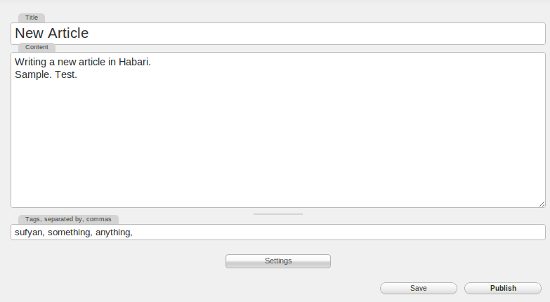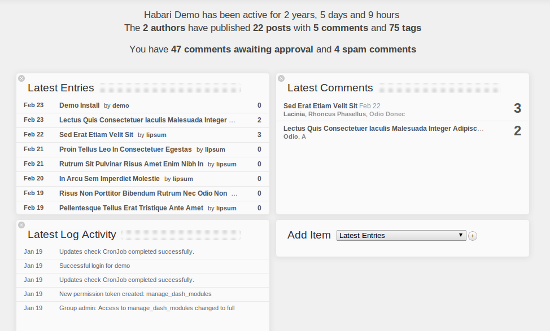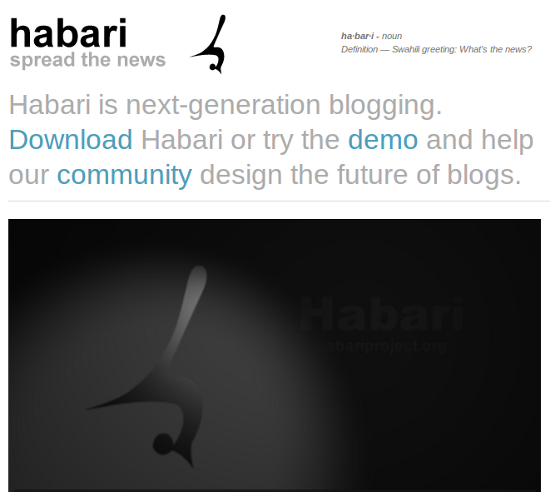Jan 28 2013
Here at Noupe, we evaluate content management systems frequently. Having covered MODX, Concrete5 and Joomla! just recently, we will now share a deeper look into Habari. Unlike previous CMSs covered at Noupe, Habari is a bloggers? CMS ? in the purest sense of the term. While it is true that you can use any CMS to create various types of websites, there should be no argument that Habari is, at least foremost, a tool meant for blogs. Considering the fact that I have mentioned the term ?blogs?, there are good chances that you might be thinking of WordPress already. Yes, since Habari is a blogging CMS, its comparison with WP is inevitable. We will cover that aspect and lots of others in the following article. So, read on?
As always, this article will bypass topics such as installation procedure and customization guidelines ? you can find such info in Habari documentation. Instead, our focus shall be to assess the usability of Habari as a Content Management System.
1. Usability (Ease of Use)
Note: Just in case you haven?t ever tried it, you can check out a working demo of Habari here.
If I were to describe the Habari interface in one word, I would most likely opt for ?usable?. Habari is one of the most user-friendly CMSs that you will ever come across. That said, it must be pointed out that the term ?usability? itself is subjective ? what is usable for me may not be usable for you, and vice versa. However, if you were to leave out the subjective elements, such as customization tools, plugins, installation of themes, etc. and focus entirely on the software?s UI, you would almost certainly find Habari to be extremely simple to use.
Basically, the key behind Habari?s usability is its minimal approach ? all you have is a simple menu with keyboard shortcuts, and a minimal interface. Trust me, you can never lose your way while using Habari.?

Article Editor in Habari
For instance, let us take up the simple task of publishing a new blog post. You will find a self-explanatory command to Create a New Article right in front of you. What else can one ask for?
On the downside, once you find your way to the New Article editor, you might miss the heavily armed TinyMCE toolbar that you are used to seeing in WP. In the end, it will take some level of ?getting-used-to?.
- Pros: Extremely swift, minimal and nimble interface
- Cons: Not meant for you if minimalism isn?t your cup of tea
2. Flexibility and Customization
Habari is flexible and you can easily customize it to suit your needs. However, it all comes down to what you wish to get out of it: if you are expecting a MODX-like customization experience, you will probably find only disappointment. On the other hand, if you like to get to the edge of things and tweak your CMS to your liking, Habari can do wonders for you.
Apparently, as far as I can get it, the pro-customization model adopted by Habari has really not been marketed well. A CMS such as Drupal or MODX can easily boast of being flexible and get away with it ? there is a huge community that is willing to back up the flexibility boast, and if they can back it up, that very boasting becomes a fact. The Habari community is a smaller entity, and naturally the ?customization examples? that one might be looking for are less in number.?

Dashboard in Habari Admin Panel
Another downside to Habari lies in the practical side of things. On the theoretical side, Habari surely is flexible. You can create photo blogs, video blogs, news websites, possibly even e-Commerce sites using it. However, when it comes to the practical affair of things, the story is different. If you are creating an e-Commerce website, you will probably opt for a CMS that has special features for you ? maybe even extra plugins. Even though you might be aware that Habari can work for you if tweaked sufficiently well, you will opt for the other CMS that offers a more ready-made solution. This is a valid choice as this method will save your time which you would?ve otherwise spent in customizing Habari.
- Pros: Flexible CMS; has the potential to power various genres of websites
- Cons: Very few practical examples of customization
3. Community and Documentation (Help and Support)
Habari has a very active and enthusiastic community. If you ever find yourself confused regarding any feature of Habari, just go ahead and ask the users ? in all likelihood, you will find a solution to your problem. In fact, if I may add, I often find the user community for smaller CMSs to be more friendly than that of a bigger CMS, such as WordPress or Drupal.
Speaking of documentation, well, it surely can be improved. The user manual and wiki are all updated and quite solid. However, it is the screen casts and other miscellaneous things that need some work ? not in terms of quality, but in terms of quantity. Habari would surely benefit from a higher number of videos and, possibly, some statistics or graphics about its usage. Love it or hate it, the internet today is a nation of pomp and show, and videos and images go a long way in winning new converts.
- Pros: Active and helpful community
- Cons: Only text wiki and docs are extensive; screencasts are pretty limited in number
4. Other Miscellaneous Elements
Habari claims that it supports multiple database backends, multiple users, static content (pages), tagging, and has importers for WP and Serendipity. Cool, isn?t it?
Actually, it is. But it needs to be more than that. As far as I can get it, having multiple users as well as support for static pages on a blog and tags cannot be called a big deal. Every other CMS supports that (it needs to die if it doesn?t).
What Habari currently needs is a good number of themes ? possibly the evolution of a framework (such as Twitter Bootstrap or Hybrid Core for WP), and responsive child themes. With the latest version, a new responsive theme having support for child themes has come into existence, by the way.?

Yes, the Habari community is passionate enough to customize the layout of their websites manually, but if Habari is to win new converts, it will have to target the section of end users as well ? and ?end users? need ready-made templates, period.
That said, Habari?s plugin repository, on the other hand, is wonderful. You will find virtually everything that might be needed for a blog: Feedburner integration, anti-spam, Flickr and Twitter integration, Disqus comments, and so on. This shows that neither the community nor the devs are lacking in talent.
- Pros: Good plugin repository
- Cons: Most themes look outdated in appearance
5. Comparing Habari With Other CMSs
Let us now compare Habari with certain other CMSs.
Bigger names such as Drupal and Concrete5 apart, I often find Habari to be similar to Wolf CMS in terms of popularity. However, Wolf CMS is not essentially a bloggers? tool. Yet, when it comes to being nimble and swift, both Habari and Wolf CMS receive an A+ on my scale.
Apparently, the present version of WordPress has evolved into a full-fledged CMS, and thus any comparison with a blogging tool happens to be flawed. I generally find Habari to be better than WordPress (oops, that makes me biased, doesn?t it?) in terms of usability.
Habari is still in its infancy ? the latest version is 0.9. Assuming it manages to stick to the minimal and nimble line of thought, where will it be when Habari 3.5 comes out? Definitely not where WordPress is today!
In my opinion, WordPress too began just like Habari ? swift and nimble. Over the period of time, it managed to turn into something bulkier. Of course, not everyone is pleased with what WP has become today. When WordPress 3.5 came out, many people expressed their unhappiness with the new Media Manager and appreciated the dismissal of the Links Manager. What does this show? A good number of WP users cringe for a minimal CMS. Trust me, when it comes to CMSs, minimalism and agility matters a lot.?
If Habari is so awesome, why is WordPress more popular, then?
Like I stated above, Habari needs a good number of themes/templates, and possibly some more ?literature? about it: community blogs, videos, etc. Furthermore, I also feel that Habari needs to re-align its focus. It already has importers for Serendipity and WordPress: I wouldn?t care much about Serendipity, though having a WP importer is awesome. Yet, most WP users will not migrate unless Habari has premium themes and numerous other glamorous concepts to its credit.
Instead, Habari needs to target the section of ?transitional users? ? folks who have outgrown Blogger and Tumblr but do not wish to opt for WordPress. Yes, I am advocating end-user migrants once again ? Habari has all the ingredients to power a tumblog and with minor touches, it can evolve as a major tool for this purpose. Similarly, judging by the way Google is treating Blogger, offering itself as a ?no-nonsense alternative? will not be tough for Habari.
But, Blogger and Tumblr are hosted services! You mean a software such as Habari should become a poor man?s WP.com?
Nope. Habari should stay what it is: a blogging CMS, not a hosted blogging service. But it needs to attempt to bridge the gap between WordPress (.org or .com) and other blogging tools. As far as I can predict, Habari will never be used much by corporate or business websites. It should focus more on bloggers ? folks who are with Tumblr/Blogger/whatever because WordPress is too complicated/bloated for them. Once more, having a good number of themes/templates might help a lot.
What do you think of Habari? Have your say in the comments below!
(dpe)
About the Author
Sufyan bin Uzayr is a 21-year old freelance writer, graphic artist, programmer and photographer based in India. He writes for several print magazines as well as technology blogs, and has also authored a book named Sufism: A Brief History. His primary areas of interest include open source, mobile development, web CMS and vector art. He is also the Founder and Editor-in-Chief of an e-journal named Brave New World. You can visit his website, follow him on Twitter or friend him on Facebook and Google+.
Homepage
Source: http://www.noupe.com/cms/habari-minimal-cms-for-more-than-light-weight-blogging-74625.html
arizona immigration law aubrey huff the killers julianne hough brandy michael pineda charles taylor
No comments:
Post a Comment
Note: Only a member of this blog may post a comment.